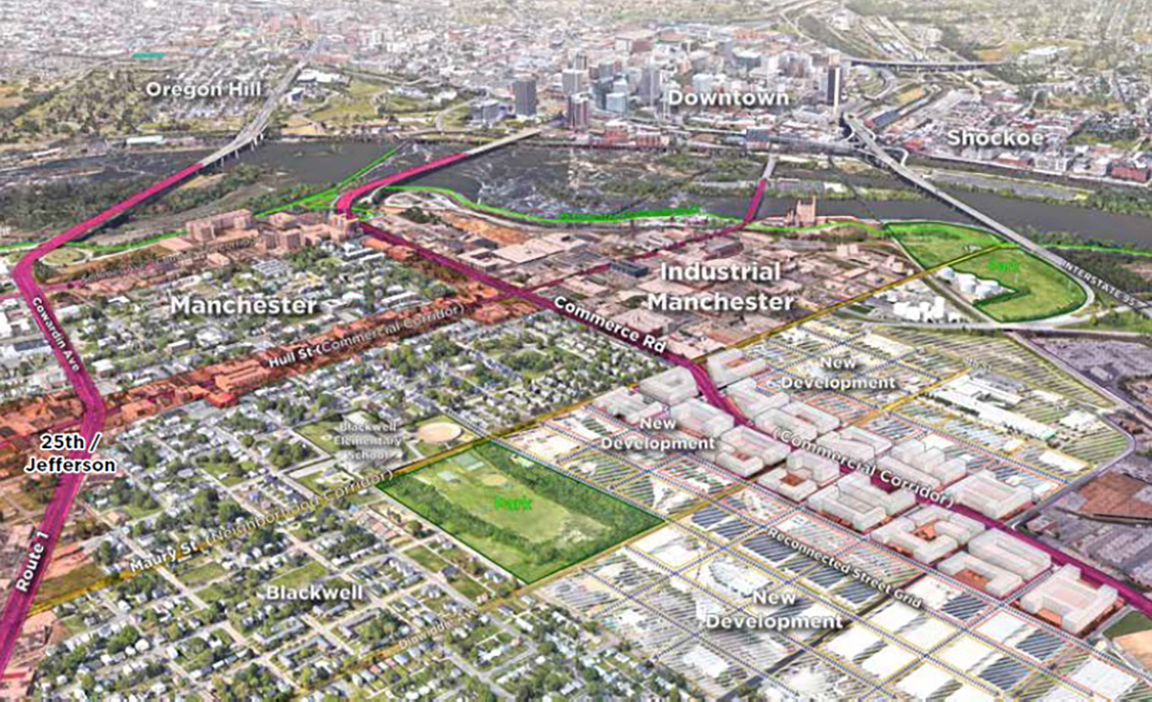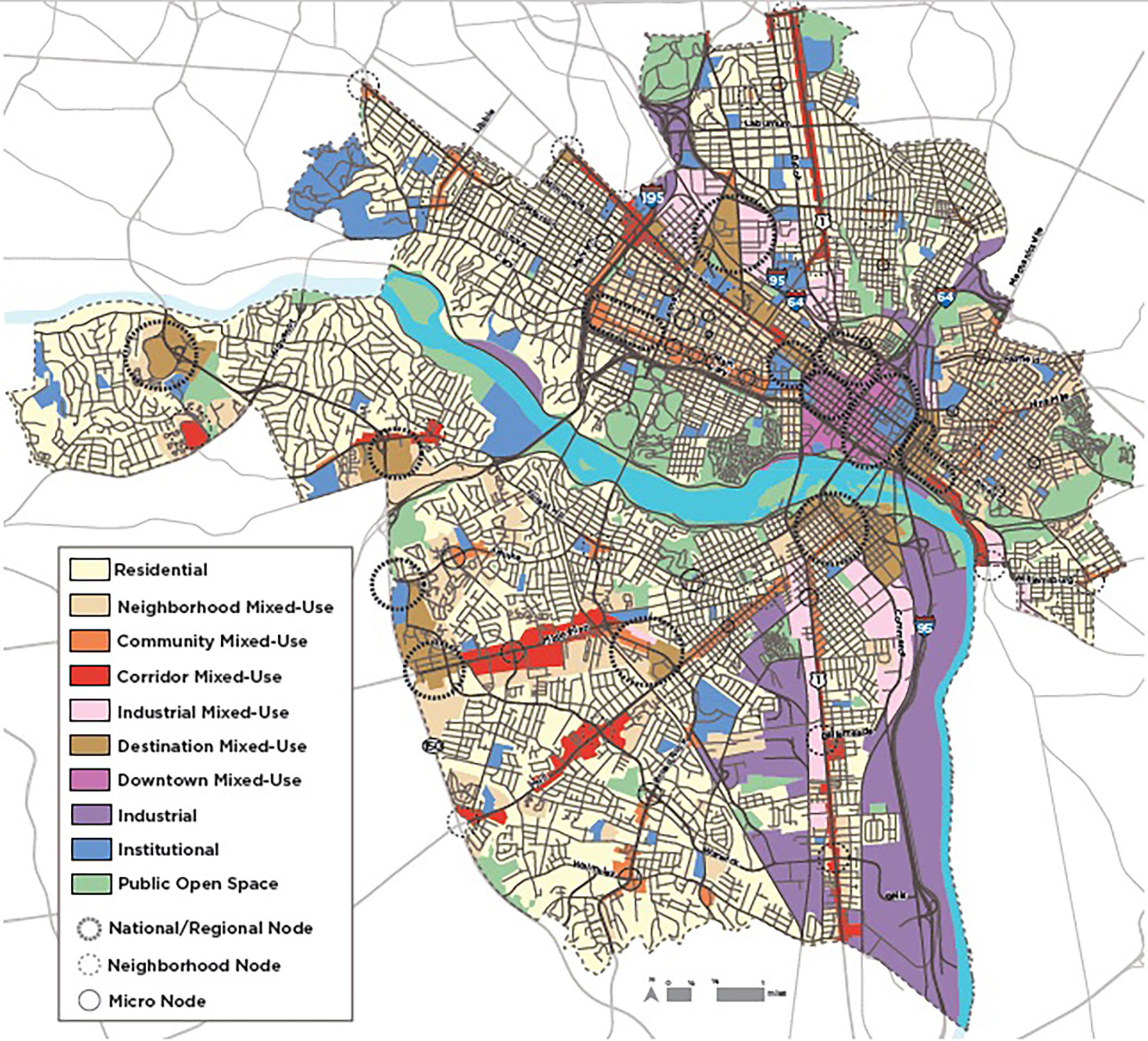
A Richmond 300 aerial rendering of priority corridors and envisioned greenspaces in the Manchester area of South Richmond. (BizSense file images)
While Richmond’s rapid bus line remains exclusively north of the river, city leaders are looking to encourage transit-oriented development growth to the Southside and even extend service there.
At its latest meeting, the City Council’s Land Use, Housing & Transportation Standing Committee endorsed a resolution that would amend the city’s zoning map to include TOD-1 designations along portions of Richmond Highway (U.S. Route 1), Midlothian Turnpike and Hull Street.
TOD-1, or Transit-Oriented Nodal District, encourages higher-density, mixed-use and pedestrian-oriented development along public transit corridors. The zoning classification was introduced in conjunction with the city’s Pulse Corridor Plan, which laid the groundwork for the GRTC Pulse rapid transit bus line.

The Richmond 300 future land use map shows a mix of recommended land uses along Route 1, Midlothian Turnpike and Hull Street in the Southside.
While the Pulse line currently extends from Willow Lawn to Rocketts Landing north of the river, TOD zoning has been implemented in areas beyond the line’s route, including owner-initiated rezonings for properties south of the river in and around Manchester.
Extending TOD further along those three commercial corridors, each of which support standard GRTC bus lines, would mirror similar efforts north of the river, where the council earlier this year continued the zoning along more of the Pulse corridor westward along Broad Street.
Behind that effort was First District Councilmember Andreas Addison, who likewise is driving this latest proposal.
At the committee’s meeting in late July, Addison said of the resolution, “This is just meant to initiate an overdue focus on what we are going to do to really improve the future development and vitality of Southside.”
A companion paper introduced along with the resolution requests north-south extensions for bus rapid transit (BRT) and related infrastructure improvements, Addison noted. It also calls for a new “high-frequency bus route” in the Southside with the goal of providing all city residents with 15-minute access to jobs, schools and services.
“This of course requires strong infrastructure such as sidewalks, bike lanes, good roads that also support pedestrian crossing, but also more importantly high-frequency transit,” Addison said. “I believe that zoning and high-frequency transit as a design can create a lot of these vibrancies we want to see across the city.”
The proposal found favor with council colleagues Michael Jones, Stephanie Lynch and Kristen Nye, whose districts make up much of the Southside. They all signed on as resolution co-patrons.
“Anything we can do to encourage development in this area,” said Jones, who represents the Ninth South Central district. “We want to be able to bike, walk and use public transit efficiently.
“The prospect of being able to take a BRT from Chesterfield Towne Center into the city on Midlothian Turnpike is a gamechanger. That would be huge for my district, to be able to go out and work in the counties,” Jones said. “I think it’s a great opportunity to improve lives, give people access to jobs and truly be able to live, work and play and get around in this area.”
The proposal follows recommendations in the Richmond 300 master plan, which recommends higher-density and mixed land uses along the corridors. It also follows previous efforts to update zoning in the Southside and along the Hull Street Road corridor in Manchester.
Lynch, who has advocated for making the Hull Street corridor in Manchester a higher priority in terms of rolling out Richmond 300’s recommendations, said the TOD proposal for the Southside’s commercial corridors is overdue and represents the culmination of previous efforts such as the Southside Revitalization Task Force.
“That revitalization plan called for a rezoning of the corridor to really align with the community’s needs and not make it what some parts of that corridor are today, which is an anything-goes, said Lynch, who represents the Fifth District. “What that’s led to is probably not the best and highest use (of that land).
“All of those things around public transit, affordable housing, walkable/bikeable communities, that really are the types of features that you see in the more affluent neighborhoods north of the river, that’s what the communities south of the river need and deserve as well,” Lynch said. “It is a path to drive some equity into the planning of the south-of-the-river corridor.”

A Richmond 300 aerial rendering of priority corridors and envisioned greenspaces in the Manchester area of South Richmond. (BizSense file images)
While Richmond’s rapid bus line remains exclusively north of the river, city leaders are looking to encourage transit-oriented development growth to the Southside and even extend service there.
At its latest meeting, the City Council’s Land Use, Housing & Transportation Standing Committee endorsed a resolution that would amend the city’s zoning map to include TOD-1 designations along portions of Richmond Highway (U.S. Route 1), Midlothian Turnpike and Hull Street.
TOD-1, or Transit-Oriented Nodal District, encourages higher-density, mixed-use and pedestrian-oriented development along public transit corridors. The zoning classification was introduced in conjunction with the city’s Pulse Corridor Plan, which laid the groundwork for the GRTC Pulse rapid transit bus line.

The Richmond 300 future land use map shows a mix of recommended land uses along Route 1, Midlothian Turnpike and Hull Street in the Southside.
While the Pulse line currently extends from Willow Lawn to Rocketts Landing north of the river, TOD zoning has been implemented in areas beyond the line’s route, including owner-initiated rezonings for properties south of the river in and around Manchester.
Extending TOD further along those three commercial corridors, each of which support standard GRTC bus lines, would mirror similar efforts north of the river, where the council earlier this year continued the zoning along more of the Pulse corridor westward along Broad Street.
Behind that effort was First District Councilmember Andreas Addison, who likewise is driving this latest proposal.
At the committee’s meeting in late July, Addison said of the resolution, “This is just meant to initiate an overdue focus on what we are going to do to really improve the future development and vitality of Southside.”
A companion paper introduced along with the resolution requests north-south extensions for bus rapid transit (BRT) and related infrastructure improvements, Addison noted. It also calls for a new “high-frequency bus route” in the Southside with the goal of providing all city residents with 15-minute access to jobs, schools and services.
“This of course requires strong infrastructure such as sidewalks, bike lanes, good roads that also support pedestrian crossing, but also more importantly high-frequency transit,” Addison said. “I believe that zoning and high-frequency transit as a design can create a lot of these vibrancies we want to see across the city.”
The proposal found favor with council colleagues Michael Jones, Stephanie Lynch and Kristen Nye, whose districts make up much of the Southside. They all signed on as resolution co-patrons.
“Anything we can do to encourage development in this area,” said Jones, who represents the Ninth South Central district. “We want to be able to bike, walk and use public transit efficiently.
“The prospect of being able to take a BRT from Chesterfield Towne Center into the city on Midlothian Turnpike is a gamechanger. That would be huge for my district, to be able to go out and work in the counties,” Jones said. “I think it’s a great opportunity to improve lives, give people access to jobs and truly be able to live, work and play and get around in this area.”
The proposal follows recommendations in the Richmond 300 master plan, which recommends higher-density and mixed land uses along the corridors. It also follows previous efforts to update zoning in the Southside and along the Hull Street Road corridor in Manchester.
Lynch, who has advocated for making the Hull Street corridor in Manchester a higher priority in terms of rolling out Richmond 300’s recommendations, said the TOD proposal for the Southside’s commercial corridors is overdue and represents the culmination of previous efforts such as the Southside Revitalization Task Force.
“That revitalization plan called for a rezoning of the corridor to really align with the community’s needs and not make it what some parts of that corridor are today, which is an anything-goes, said Lynch, who represents the Fifth District. “What that’s led to is probably not the best and highest use (of that land).
“All of those things around public transit, affordable housing, walkable/bikeable communities, that really are the types of features that you see in the more affluent neighborhoods north of the river, that’s what the communities south of the river need and deserve as well,” Lynch said. “It is a path to drive some equity into the planning of the south-of-the-river corridor.”



Regional/National nodes at Belt Blvd between Midlothian and Hull Street?? Forest Hill at Chippenham; the Diamond(less) District are regional…….oh the City planning department and their imaginations.
Considering were going to have 10 billion humans by 2058 and the Richmond region has very nice weather and taxes between now and then any place they up zone will be filled up as prime real state. I think the City should upzone everything along Huguenot Road between the City limits and the James River with 10 and 15 story tall buildings. And all new buildings should be upzoned to a mimimum of 15 stories to deal with the massive levels of growth. The City of Richmond is doing a very nice job as a people sink allowing a place… Read more »
Massive growth??? Most cities since 2020 are seeing flat to negative growth in the City including Richmond. In fact despite lots of 1-bedroom apartments the city has continues to see household size shrink. Lots of empty nesters (buying older row homes) and young persons (in the new apts) are filling up city housing stock. City population under 18 yrs old has continued to shrink. It was around 25% person under 18 in 2010 and that number in the 2021 estimates have it under 18%. And our suburban/ex urban growth sprawl continues to spread. Western Chesterfield was estimated to have 6000… Read more »
Housing prices and demand for housing are skyrocketing out of control. Every one of these hunderd home and apartment unit projects seem to fill up from day one before they built.
This is a very good effort by the city. I hope the proposed zoning changes are implemented soon! Onward to a more sustainable and beautiful city.
Richmond can improve it’s fiances by upzoning in that water and sewar and streetpaving and sidewalks are a fixed cost while adding more units to a acre raises the amount of profit that is returned to the city.
Richmond should look into on-demand public transit. Many US cities are going this route. (Seeing so many empty buses every day makes me think that there must be a better way. BTW, I used to ride the bus on a regular basis. I wonder how many of these city planners can say the same thing.)
Here is a quick link: “Is on-demand public transit now mainstream in the US?”https://ridewithvia.com/resources/articles/is-on-demand-public-transit-now-mainstream-in-the-us/
So true; I enjoyed riding the bus as city employee but even with free pass I saw few co-workers in the 2000s (on the old Rts. 3, 4, or 6) but I can tell you when some died or retired the FIGHT for the new freed parking space under City Hall was like Mortal Kombat cage match!